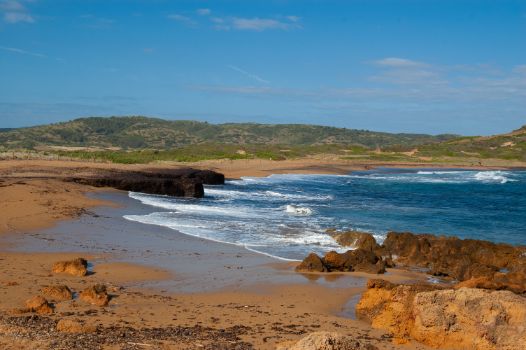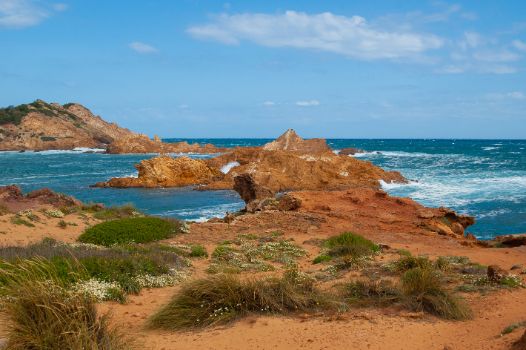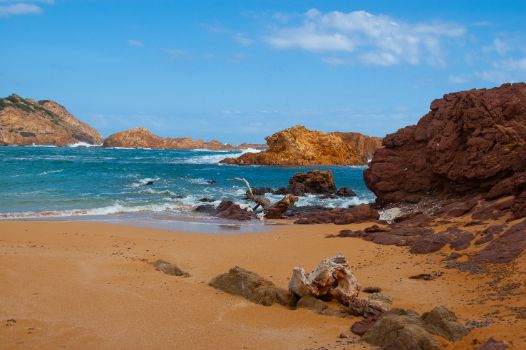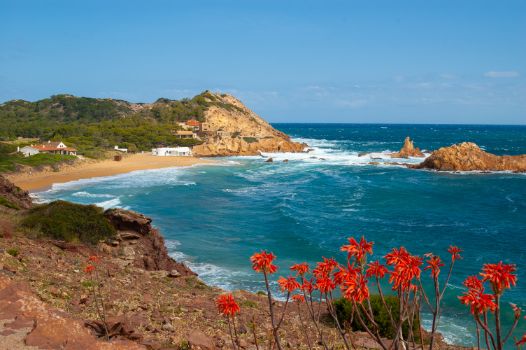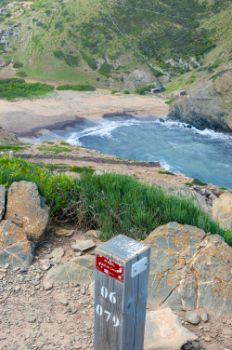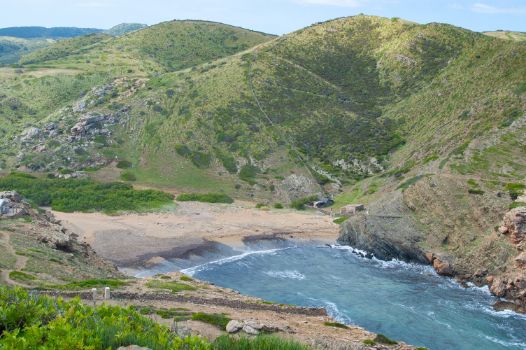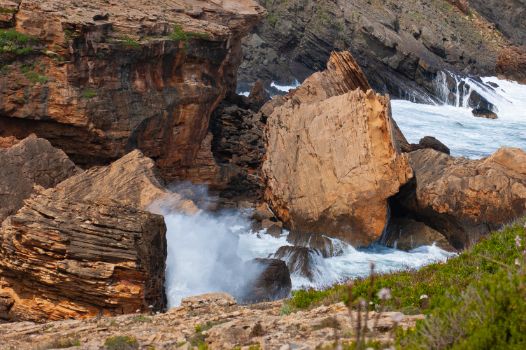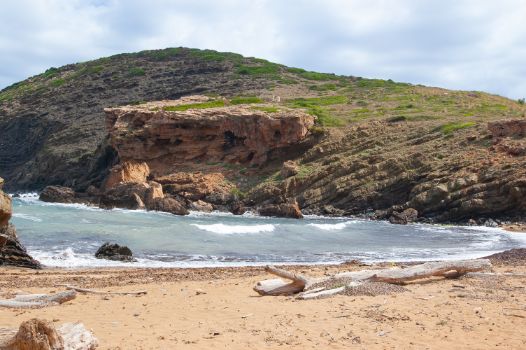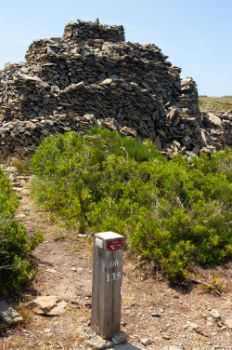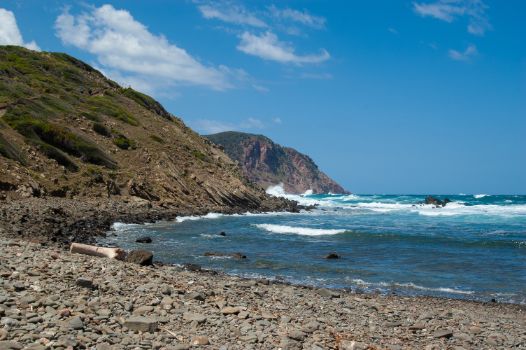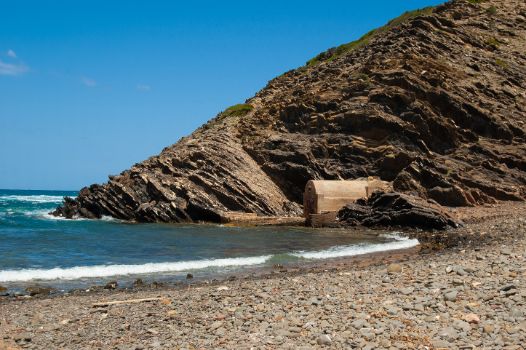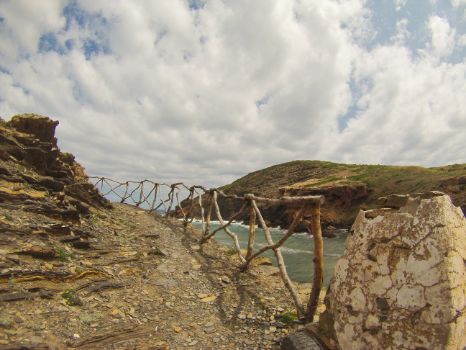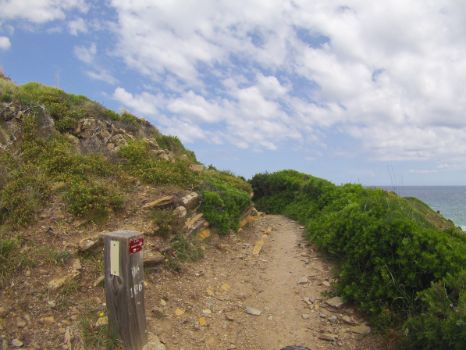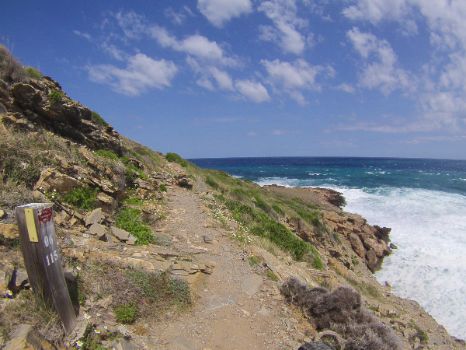
Net of Natural
Trails

Stage 6: Binime.là – Els Alocs
Description
Menorca's wildest coastline, the island's most virgin beaches
Despite its short length, this is a challenging stage since it goes through one of the most rugged areas of the island of Menorca, but at the same time, it is one of the most rewarding, since you will be able to visit spectacularly beautiful virgin coves such as Pregonda Cove, Barril Cove and En Calderer Cove. The starting point of the stage on the beach of Binimel.là and the end on the hidden beach of Els Alocs are also impressive.

The Nature Trail information board located at the eastern end of Binimel·là beach marks the beginning of this new stage, one of the most challenging of the Camí de Cavalls Nature Trail. The traveller begins his adventure by crossing this beautiful sandy area and its dune system full of biodiversity. Shortly afterwards, take the path that leaves from the western end of the aforementioned beach, following the now familiar markers and overcoming one of the ever-present Menorcan gates.
After a short walk you reach another small cove. Just opposite, on the other side of the route, you can see the Calasmorts temporary pond. The water of this small lagoon have a low salt content. Together with its small size and highly seasonal nature, is one of the most fragile ecosystems on the island of Menorca.
An uphill ramp foreshadows what will be the predominant tone throughout the stage. Subsequently, you will arrive to the spectacular cove of Pregonda. This is, without a doubt, an idyllic place, in which the azure colour of its crystalline waters is its main sign of identity.

The trail continues, overcoming a small stretch of wide path at the same time as it leaves Cala Pregonda, at which point the enters an area with larger vegetation that temporarily moves away from the coastline to a an area with larger vegetation to, shortly afterwards, coming closer to it again, in time for you to enjoy the views on Cala Barril: a small virgin cove that invites you to chill for a few minutes.
After Cala Barril there is a challenging uphill stretch, but not without a reward: as after half of this stretch you will be able to enjoy spectacular views. At this point, you have to cross a new Menorcan gate. On the other side, there is a stretch of gentler slopes with another example of Mediterranean scrubland where, with a bit of luck, it is possible to see some Balearic donkeys.
The trail continues climbing towards Punta Cala Calderer. From there, you can see the beach of the same name, the next gem on this stage full of hidden surprises. The route descends all the way down to the Cala en Calderer, crossing it from east to west; please make sure to take as long as you need to enjoy this paradisical beach.
Leaving this beautiful beach behind, and after overcoming a new Menorcan gate next to a couple of old fishermen's houses, a new stretch of ascent begins. In this area, the route advances further away from the coastline, reaching an old circular stone building known as a barraca, used for sheltering livestock.

A little further on, a signpost states that in 2.1 km you will reach the end of the stage. At this point this trail begins going down, crossing a landscape dominated by Mediterranean scrubland. After crossing new Menorcan gate with its corresponding waymarker, you will arrive at another waymarker that marks the end of the descent; at this point, the path becomes wider for last few metres that separate this point from the beach of Els Alocs.
Here you will be welcomed by the hidden beach of Els Alocs, which is difficult to access and has a special charm and tranquillity, and marks the end of this stage. This pebble beach owes its name to the chasteberry tree (Vitex agnus-castus), aloc in Catalan, a deciduous shrub that is very abundant in the area. You have completed this stage; the only thing left to do is to enjoy this beautiful spot, allowing yourself to be overcome by the magic of the place.
Links of interest
Profile

(Calculated according to the MIDE criteria for an average excursionist with a light load)
Highlights
Menorcan gates
These have traditionally been the gates used in the agricultural estates of Menorca, and they are locally known as tanques (or each of them, a tanca). In Menorca, agricultural estates are completely enclosed by dry stone walls, and the gates are placed at the points of entrance (portells). They are handmade from wild olive wood (Olea europea var. sylvestris), a very abundant wild olive tree on the island, which grows slowly and produces very resistant wood. Generally eight crossbeams are required to build a single of these gates.
The truth is that today they are much more than what they were originally used for. Nowadays, they have become one of Menorca's major signs of identity: they are a symbol of its cultural heritage and their use as an enclosure and ornamental element has been extended to all types of homes.
The Tramontane
The tramontane wind (locally, the tramuntana) is the predominant wind on the island of Menorca. It is a cold north-northeast wind associated to dry weather. Due to its distance from Menorca to the mainland and the fact that it is less sheltered, the tramontane is harsher here, and has shaped and carved the northern coast of the island. The strong winds have caused numerous shipwrecks; this is the reason why the north coast has more lighthouses than usual.



